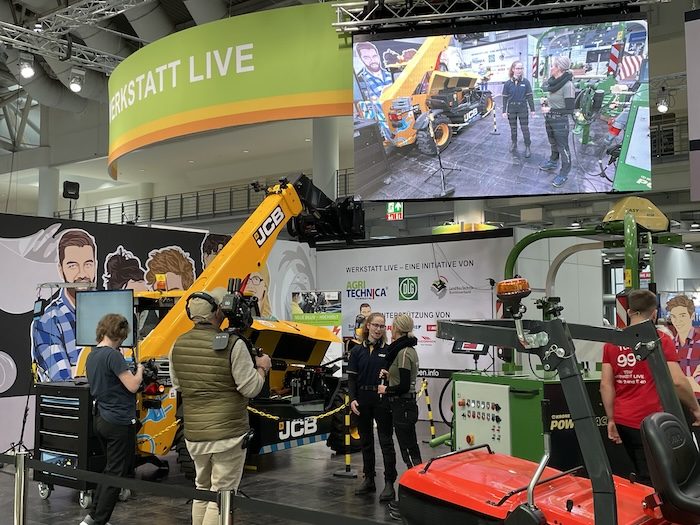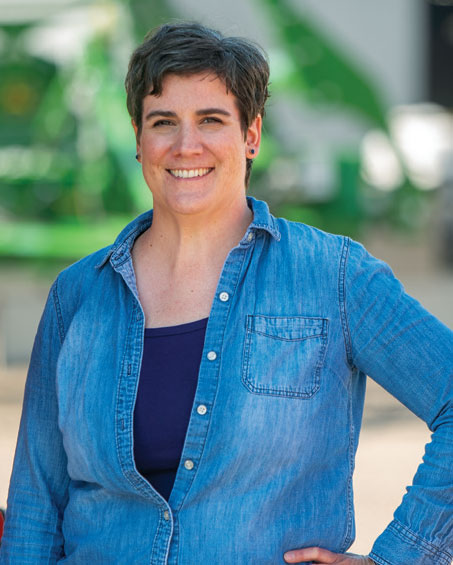Agritechnica drew a record crowd of 470,000 visitors from 140 countries to Hanover, Germany. The week-long show featured 2,812 exhibitors from 52 countries in 24 halls. The international show, which is usually held every 2 years, made its first return in 4 years after being canceled due to COVID-19.
Ahead of the show, 251 products were registered for the Agritechnica Innovation Award, one of the leading awards within the international ag industry. It is awarded to innovations for use in a practical setting and underscores the value of modern agricultural machinery to farming.
“The main impression is that these innovations are focused not only on new models like autonomous tractors, new designs with higher productivity, wider functionality and better service, but also at improved control of machines and promptly developing precision agriculture,” says Viktor Sych, a former Kuhn executive in Ukraine and now a consultant for dealers and manufacturers, and one of Farm Equipment’s Agritechnica correspondents. “The machines and solutions that got medals during Agritechnica 2023 and the title of Farm Machine 2024 just prove this trend.”
The following are just a taste of some of the new technologies and products introduced at the show. Special thanks to Hein Geluk, Sych and Roger Murdock for helping as correspondents during the show.
Krone & Lemken Combined Powers
The Combined Powers concept vehicle, which was developed by Krone and Lemken, is an autonomous drive unit that acts as a smart system that can plow, cultivate, sow, mow, turn and swath. Charlotte Peters, Lemken product manager, says the companies approached the project thinking about the implements needs vs. the engine’s needs. The autonomous unit was developed to optimize the implement’s process. No word yet on when the technology will be available, but field testing is underway, Peters says. Combined Powers received a Silver Innovation Award.
 Lemken (top) and Krone (bottom) Combined Powers concept vehicle. All Images by: Kim Schmidt
Lemken (top) and Krone (bottom) Combined Powers concept vehicle. All Images by: Kim Schmidt
Amazone, Claas & AgXeed 3A
Amazone, Class and AgXeed received a Silver Innovation Award for their 3A – Advanced Automation & Autonomy. 3A connects tractors and implements to the planning and autonomous implementation process using an ISOBUS interface.
Leonie Guerts from AgXeed says the companies realized they needed to work together and build an open system to find autonomous solutions. In addition to the track machine, Agxeed also has the AgXBox, a kit that can make an existing tractor autonomous. She says one track machine customer has already put 2,000 hours on their machine. She adds it can work in the field for 23-24 hours a day.
 Amazone, Claas & AgXeed 3A
Amazone, Claas & AgXeed 3A
Trimble & Billberry Technology
Trimble had Billberry on display at its booth for the first time since acquiring the French technology company that specializes in selective spraying systems for sustainable farming, Dave Britton, vice president of product management for Trimble Ag, says the company will be focusing on the North American and Latin American markets for the technology. He also said that when it comes to its cloud, Trimble is focused on improving data management, while also making sure the cloud and field experiences are more integrated.
Agrointelli Robotti
The Robotti uses dual RTK-GPS positioning systems that give it +/- 2 centimeter accuracy. It has a standard 3-point hitch, making it universally compatible and easy to customize to standard implements. Distribution is already set up in Canada and sales manager Jess Pedersen says there are plans for the U.S, possibly in the next 2-3 years.
 Agrointelli Robotti
Agrointelli Robotti
AEF AgIN Initiative
Over at the AEF booth, Andrew Oliver, AEF chairman, talked about the organization’s new AgIN initiative. AgIN will enable peer-to-peer cloud connections, creating an industry-wide data-sharing solution for those who agree to interoperability. AgIN is a network and not a new platform. AEF members may join the AgIN network with their existing cloud platforms and access each other’s services, ensuring data flows securely through the entire network.
Each participant will continue to host its own platform and service and will gain access to connect with other AgIN participants. AgIN joins the European dataspace initiatives (DSI) to collaborate with other DSIs. The AEF member companies that have committed to the AgIN initiative include Actia Italia, the Assn. of Equipment Manufacturers (AEM), AGCO, AgGateway, Argo Tractors, Amazone, Bosch Rexroth, CLAAS, CNHi, dev4Agriculture, Dinamica Generale, DKE-Data, Horsch, John Deere, Krone, Kubota/Kverneland, Kuhn, SDF, NEXT Farming, OSB connagtiv, Pöttinger, Rauch, Trimble, VDMA Agricultural Machinery, Walvoil and xFarm.
Oliver says AEF is applying what it learned from its work on ISOBUS to making it easier for farmers to access all their data from various sources in one place. He expects the prototype to be up and running by winter of 2024.
Kuhn Introductions
Kuhn 120id Baler. The 120id baler is unique because it has a split plunger that compresses the material to be baled. Conventional balers have one plunger, which demands high peak power when making a compression stroke. The 1290id model has the same size plunger but is split in two pieces. First the lower half will hit the material, so compression starts with half the required power. After 4 inches of stroke, the second part of the plunger starts compressing. This way, the peak power is cut off, and the power requirement is about 20% less than a conventional baling system. Kuhn claims to have increased the bale density by about 25%. It does not place the baler in the extreme high density range like Krone with its HDP2 model, but it finds itself in the middle between conventional and the HD.
 Kuhn 120id Baler (top), Triple Mower-Conditioner (middle) and the Karl Concept (bottom)
Kuhn 120id Baler (top), Triple Mower-Conditioner (middle) and the Karl Concept (bottom)
Triple Mower-Conditioner. Kuhn received the Farm Machine 2024 honors at Agritechnica 2023 for its new and widest triple mower-conditioner with swath grouper FC13640 RA, which can be retracted. Its belt grouper forms a swath about 1.80-3 meters wide with the forage collected over a cutting width of more than 13 meters. Mowing a large area with a single machine allows substantial savings on pulling power, fuel and labor costs.
Karl Concept. The autonomous Karl is a concept in development offering new technical possibilities and great working flexibility and can be used with a variety of implements. Karl carries out work without human intervention. Once the plot has been delimited, the operator creates a work mission, places Karl in the plot, adjusts the work parameters and starts the mission which then runs automatically. The tool linked to Karl transmits the information necessary for proper work performance, and Karl adjusts its parameters accordingly. It’s worth mentioning that previously Kuhn already developed autonomous feeder-mixer Aura.
Väderstad Tempo Coming to America
The Tempo series of planters have been in the European market for 10 years, but in 2024 they’ll make their North American debut, says Jennifer Heimer, director of marketing and communications for Väderstad North America. The new features and electronic WSX system for Tempo L 8-32, Tempo V 6-12 and Tempo F 6-8 premiered at Agritechnica. A limited series of machines will be available in the field for the spring of 2024, with serial production beginning in the summer of 2024.
The new electronic system WSX will be introduced to Väderstad Tempo F, Tempo V and Tempo L in the summer of 2024. With the upgrade to the electronics of the planter, new features to ensure accuracy in the field are enabled. These new features include automatic seed singulation, active hydraulic row unit downforce and curve compensation.
“The new WSX system enables us to integrate 3 new features to further optimize the accuracy of the Tempo planter,” says Oskar Karlsson, director of planter product management at Väderstad.
 Väderstad Tempo L 8-32
Väderstad Tempo L 8-32
First, automatic seed singulation is introduced to always ensure precise seed singulation in the seed meter, without the need for manual setting.
With sensors in each row unit, the seed singulation is continuously monitored and automatically adjusted to the optimum setting. The automatic singulation saves time and increases productivity in the field, a feature that will especially be appreciated by farmers who regularly change crops, says Karlsson.
Active hydraulic row unit downforce is introduced to ensure an exact planting depth, independent of soil conditions. The system will adjust row unit pressure to the ground, depending on the soil conditions. When going over a lighter field area, the pressure will decrease, and when entering an area with firmer soil conditions, the pressure will increase. The planter can be equipped with individual active hydraulic downforce for each row unit, or with active hydraulic downforce using a single point feedback and universal control for the full machine width.
The active hydraulic downforce allows the driver to set an optimal row unit downforce, which is maintained automatically. This ensures planting depth precision despite changing soil conditions, such as variations in soil type or soil compaction.
McHale V8960
McHale introduced the V8960 (pictured) and the V6760 during Agritechnica. The new balers are fully automated and ISOBUS controlled, says Mike Walsh, sales and marketing for McHale. The V8 can make up to 6-foot bales and is available with a 15-knife chopper unit. The auto greasing and oil makes it maintenance free while operating.
 McHale V8960 Fully Automatic High-Capacity Chopper Baler
McHale V8960 Fully Automatic High-Capacity Chopper Baler
New Holland CR11 Combine
The Gold Innovation Award went to the New Holland Agriculture CR11 combine. The Canadian no-tillers who were checking it out noted how it could help reduce labor needs because they could get by with fewer combines with the CR11’s higher productivity. The new combine has close to zero grain loss, higher throughputs and more automation that cuts down on the total cost of harvesting. It has a 775 horsepower C16 engine, 2-by-24 inch rotors, a 567-bushel grain tank and a 6-bushel per second unload rate.
 New Holland CR11 Combine
New Holland CR11 Combine
Poettinger Novacat & Mergento Series Updates
In Poettinger’s new mower combinations, Novacat V 8400 and V 9200, with a working width of 8.4 and 9.2 meters, the hinge and the unloading system have been completely updated. Angled booms allow for an extremely short headstock. The beams remained in the same place and provide the same minimum turning radius, but the central part was moved closer to the tractor. Both mower combinations are available with swath formers, ED tine-type conditioners or RC roller conditioners.
Poettinger adds to its line of rakes with the belt merger Mergento V 9200, which collects forage using the pick-up with a working width of up to 9.2 meters and forms uniform swaths. Engineering solutions ensure the most gentle treatment of alfalfa, clover leaves and a wide variety of crops from permanent grassland to straw. The overall result is more energy, more crude protein and less crude ash in the forage.
Related Content:




![[Technology Corner] Discussing AI’s Potential Impact on Service & Support](https://www.precisionfarmingdealer.com/ext/resources/2025/04/11/Discussing-AIs-Potential-Impact-on-Service--Support.png?height=290&t=1744385717&width=400)


